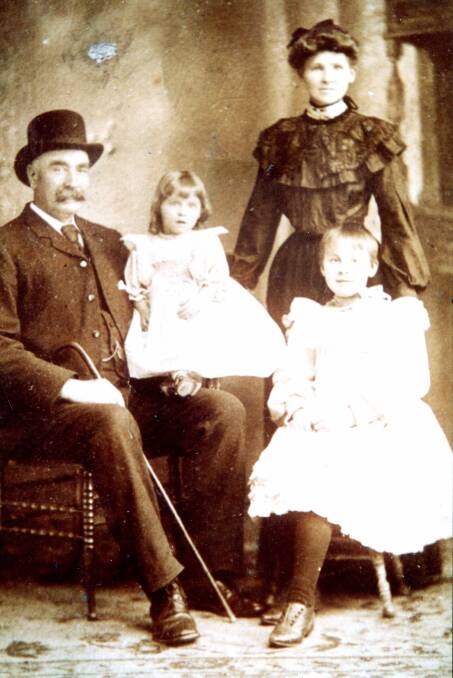
OUR photo this week is of a Kelso policeman who was in charge of the cottage and jail on Sydney Road. It shows James Barnes and his wife Emily with their younger daughter Ivy, who was called "Doll", and her elder sister Eily Fredricka at the front.
James Barnes was born on March 13, 1854 in England. He was the son of Anthony and Margaret Barnes (nee Ellwood).
Subscribe now for unlimited access.
$0/
(min cost $0)
or signup to continue reading
He emigrated to the Southern Colony in 1882, where he joined the New South Wales Colonial Police Force as a foot officer, probationary constable on January 25, 1883. He was assigned number 4341.
James was six feet and a half inch tall and his religion was listed as Protestant. His records said he had brown hair and hazel eyes and a "fresh" complexion.
James was transferred to the South Western District on February 6. He was stationed in Hay, where he was promoted to constable by May 1883.
There was another transfer when he was moved to Wentworth, adjacent to the Murray and Darling rivers, in what became the South-West Riverina region of NSW. He arrived around 1891.
On James' departure, he was presented with a gold watch on which was inscribed: "Presented to James Barnes. On the eve of his departure from Hay. By the Mayor and a few friends."
He got married in 1891 at Wentworth after his fiancée Emily had left Kangaroo Gully to look for domestic work in southern NSW.
At the time of their marriage, James was 36 and Emily was 10 years younger.
James became constable first class while in Wentworth and, in 1906, was transferred to the Western District, where he and Emily lived in Cowra for a short period.
Not long after they had moved to Cowra, James was offered a promotion if he moved to Kelso, near Bathurst. He accepted. Constable James Barnes, of Cowra, succeeded Constable McGillan at Kelso, the latter having arrived in 1876.
Kelso's first Police Lockup, or Watch House as it was also known in early correspondence, was constructed around 1845.
It was located on the road to Peel, now Gilmour Street, where the current Kelso Public School was constructed much later. This first Kelso Lockup was condemned around 1890.
After finding a suitable site on Sydney Road, the Government Architect drew out a plan.
In mid-November, 1892, the Bathurst Times newspaper noted that the Government Gazette carried an advertisement calling for tenders for a new Kelso Lockup.
Eight tenders were received, but they were all considered too expensive.
New tenders were called for at the end of 1894. The successful tenderer had submitted a price of £1169 ($2338), considerably less than the lowest tender some two years previously.
Finally, construction of the new facility began in August, 1895. The new building included two cells, an open-roofed exercise yard, known as the "grill yard", with urinal and water closet, kitchen and a single man's room at the back of the building.
The rest of the building included pantry, sitting room, two bedrooms, a charge room, bathroom and two verandahs.
The brick building had a corrugated iron roof and was constructed on a concrete foundation. The rear cells and exercise yard were of brick in double English bond, 500 millimetres thick, with sandstone blocks which were brought from Sydney by rail.
Emily was always sick, so her younger sister came to live with the Barnes family to look after James' wife.
Emily died of consumption (tuberculosis) on June 3, 1908 and was buried in the cemetery around Holy Trinity Church at Kelso.
After Emily's death, James married Vene some two years later, but not before having to change churches and becoming devout Baptists.
James Barnes died at Kelso on June 22, 1914 and was buried beside his wife.

